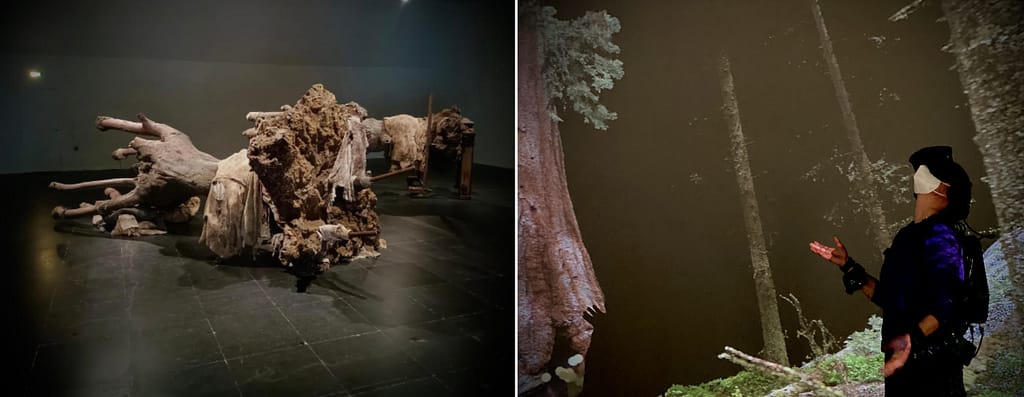
Experiencing Art Installations: Does it matter whether it’s physical or virtual?
This post was written in collaboration with Ralf Cox, PhD., Hector Gallegos, MA., and Lisa-Maria van Klaveren, MSc.
Are Virtual Reality (VR) art installations different from traditional artworks such as installations with sculptures in an exhibition hall?
With this question in mind, our research team (the Measuring Experience and Meaning of Art group, or MEMA, of Ralf Cox, Ph.D.; Gemma Schino, MSc.; Héctor Gallegos González, MA; and Lisa-Maria van Klaveren, MSc.) reached out to the Frankfurt Art Association (German: Frankfurter Kunstverein, FKV), an art museum located in the heart of Frankfurt (Germany).
Together with the FKV’s director and art curator Franziska Nori, we selected artworks that could serve our goal and set a pop-up lab in the museum, so as to have ecologically valid stimuli and an ecologically valid setting for experiencing art (Hayn-Leichsenring, 2017; Carbon, 2019). Two installations were selected from the exhibition “The Intelligence of Plants – an Alliance of Science and Art” (see Figure 1). The first one is Embalmed Twins by Berlinde De Bruyckere (2017). It consists of monumental sculptures of two fallen trees made of wax, fabric, leather, rope, wood, iron, and epoxy. The second one is the TreeHugger: Wawona, a multimedia VR installation by Marshmallow Laser Feast (2017), and shows the inner world of a giant sequoia tree. Because these installations are created with very different tools and materials, visitors meet the trees in very different ways: either by walking in the room where the sculptures of the fallen trees are physically present, or by relying on their feeling of presence in a virtual space surrounded by trees.
Figure 1. Installations selected as stimuli for the pilot.
Note. On the left: Berlinde De Bruyckere, Embalmed Twins I and II (2017), installation view Frankfurter Kunstverein 2022, Photo: Héctor Gallegos González.
On the right: Marshmallow Laser Feast, Treehugger – Wawona, (2017), installation view Frankfurter Kunstverein 2022, Photo: Gemma Schino.
The two installations share the goal of connecting the audience with nature as they recall the great height and vastness of trees. According to the expertise of the art curator, both installations move the audience and involve their body on their own terms. The question for us is how exactly does this involvement happen? How can we measure it? We measured the art experience of visitors that voluntarily took part in the study along the affective dimension, as well as the physiological and behavioral dimensions. For this, we relied on:
1. the Empatica E4 Wristband, which enables us to record electro-dermal activity (EDA), heart rate (HR), blood volume pulse (BVP), and interbeat interval (IBI) (Schuurmans et al., 2020), and motion-based activity.
2. Questionnaires enabling us to assess the subjective dimension of the experience. These included self-report tools such as Bodily Sensation Maps (BSMs, Nummenmaa, et al., 2014), Geneva Emotion Wheel (GEW, Scherer, et al., 2013), and Perceived Self-Size scale (PSS, Bai, et al., 2017) to capture different qualitative aspects of the emotions.
In our design, quantitative and qualitative methods were used conjointly to provide a broader perspective of the nature of the art experience. Firstly, these methods aim at grasping both the process of the experience while it is actually happening and the resulting emotions together with the feelings that underlie them (Carbon, 2020). Secondly, their combination can bring closer together the interpretation of data drawn from physiological and behavioral measurements and descriptive findings of the questionnaires. For instance, while the Empatica E4 can tell us about EDA which can be an indicator of the strength of the feelings underlying the emotion, we also need a tool like the GEW to determine the emotional quality and the valence of what we are feeling. With the idea of a multimodal approach, we aimed at capturing different aspects of the complex and multilayered experience surrounding art encounters.
In our design, quantitative and qualitative methods were used conjointly to provide a broader perspective of the nature of the art experience. […] With the idea of a multimodal approach, we aimed at capturing different aspects of the complex and multilayered experience surrounding art encounters.
With the data we acquired, we can compare the experience of a VR art installation with that of a sculpture, a more traditional art form. In our pilot, both installations evoked very intense emotions, both positive and negative. Preliminary findings focused on the questionnaires’ results concerning the visitors’ perceived self-size and bodily sensations. They suggest that the panorama technology used for the VR installation relates to the way participants thought about their own size in the environment. Although one could assume that the vast environment created through technology makes us feel small when compared to the giant sequoia trees shown in the VR installation, the first glance at our results shows the opposite. It seems the installation put most of the visitors on par with the vastness of nature shown through the VR installation. On the other hand, the experience of the monumental sculptures in a physical environment made more than half of the participants feel small.
The use of VR may also have influenced the visitors’ perception of the physical sensations of their bodies. The feeling of activity getting weaker in the body (i.e.: deactivations) seems to differ considerably between the two types of installations. Notably, the sense of the internal state of the body reported via the BSMs in the VR installation seemed to be affected by the equipment worn during the experience. Deactivations concentrated on the shoulders, which may relate to the weight of the Mobile Battery Harness, worn as part of the VR equipment. Thus, during VR experiences, visitors’ sensations seem to be engaged with the artwork but also with the equipment – something artists using VR should be aware of.
Do these factors play a role in the final aesthetic judgment of the experience? What does it say about the feeling of immersion and connectedness with the artwork? There are still many analyses to be run before all questions can be answered. This pilot left us with the desire to discover and explore more about the dynamic and complex phenomena related to art experiences. And what we have experienced is that the best way to investigate such encounters is by altering the experience of visitors with the installation as little as possible (Mazzocut-Mis et al., 2020).
References
Bai, Y., Maruskin, L. A., Chen, S., Gordon, A. M., Stellar, J. E., McNeil, G. D., Peng, K., & Keltner, D. (2017). Perceived Self-Size Scale. https://doi.org/10.1037/t63774-000
Carbon, C. C. (2019). Empirical approaches to studying art experience. Journal of Perceptual Imaging, 2(1), 10501-1. https://doi.org/10.2352/J.Percept.Imaging.2019.2.1.010501
Carbon, C. C. (2020). Ecological art experience: How we can gain experimental control while preserving ecologically valid settings and contexts. Frontiers in psychology, 11, 800. https://doi.org/10.3389/fpsyg.2020.00800
De Bruyckere, B. (2017). Embalmed Twins I and II [installation with sculptures made by wax, fabric, leather, rope, wood, iron, epoxy]. Frankfurter Kunstverein, Frankfurt, Germany. (n.d.) Retrieved from: https://www.fkv.de/en/berlinde-de-bruyckere/.
Hayn-Leichsenring, G. U. (2017). The ambiguity of artworks–a guideline for empirical aesthetics research with artworks as stimuli. Frontiers in psychology, 8, 1857. https://doi.org/10.3389/fpsyg.2017.01857
Marshmallow Laser Feast (2017). Treehugger: Wawona [VR experience and installation]. Frankfurter Kunstverein, Frankfurt, Germany. (n.d.) Retrieved from: https://www.fkv.de/en/marshmallow-laser-feast/.
Mazzocut-Mis, M., Visconti, A., Tahayori, H., & Ceria, M. (2020). Sublime Experience: New Strategies for Measuring the Aesthetic Impact of the Sublime. In Imagine Math 7 (pp. 167-187). Springer, Cham. https://doi.org/10.1007/978-3-030-42653-8_11
Nummenmaa, L., Glerean, E., Hari, R., & Hietanen, J. K. (2014). Bodily maps of emotions. Proceedings of the National Academy of Sciences, 111(2), 646-651. https://doi.org/10.1073/pnas.1321664111
Scherer, K. R., Shuman, V., Fontaine, J., & Soriano, C. (2013). The GRID meets the Wheel: Assessing emotional feeling via self-report. Components of emotional meaning: A sourcebook. https://doi.org/0.1093/acprof:oso/9780199592746.003.0019
Schuurmans, A. A., de Looff, P., Nijhof, K. S., Rosada, C., Scholte, R. H., Popma, A., & Otten, R. (2020). Validity of the Empatica E4 wristband to measure heart rate variability (HRV) parameters: A comparison to electrocardiography (ECG). Journal of medical systems, 44(11), 1-11. https://doi.org/10.1007/s10916-020-01648-w
Note: Featured image by Gemma Schino.




